Editor’s Note 5/19/16: In celebration of National Bike Month in the United States, Sightline is bringing back this cargo-bike classic. Since this article was published in 2012, cargo bikes have gained popularity and are seen all over Cascadia and beyond. Do you own a cargo bike? We want to know what you tow! Email us a photo at editor@sightline.org.
It’s been a hard few months for us fossil-fuel-addicted societies: calamity in the Gulf of Mexico; coal mining disasters in China, West Virginia, and Russia; still-frustrated attempts to win climate and clean-energy policies in Salem, Olympia, and Washington, DC. Perhaps we’re hitting bottom?
If so, catching glimpses of a life cured of addiction can be a step toward recovery. To that end, I’ve been devoting odd moments this year to marveling at some of the innovations going on in human-powered urban transportation: walking carts, community carts, and convertible cart-trailers.
Today: a report from the edges of human-powered conveyance, where pedal pushers are hauling car—and pickup-worthy loads on cargo bikes and trikes. The ingenuity evident across the Northwest and the world in finding practical, nonmotorized solutions to the daily challenges of urban mobility is heartening, even inspiring. It’s also sometimes whimsical and amusing.
Given a price on carbon, policies that grow compact communities, and adequate investment in safe, segregated bikeways, such inventions will proliferate. They’ve already won toeholds in the Northwest’s cities.
Pictured below, for example, are my Seattle neighbors John Floberg and Lisa Hellefond on their weekly grocery run. Their vehicle is their “long tail,” a bike suitable for hauling not only John but also 200 pounds or more of (Lisa and) groceries.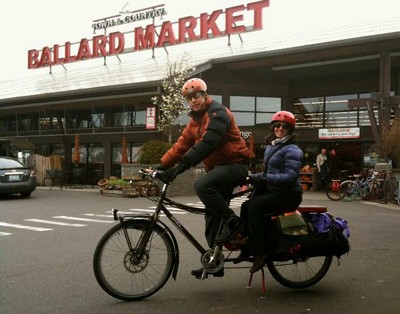
Varieties
Long tails, which put their load in the back on sturdy extended racks, are but one type of cargo bike. (Long tail examples include the Kona Ute, HammerTruck, Yuba Mundo, Work Cycles Fr8, Torker Cargo-T, Batavus Personal Delivery Bike, Surly Big Dummy, and the Xtracycle, which bolts onto a regular bike to make it a long tail. John and Lisa ride an Xtracycle.)
Others, called long johns, put the load in the front. (Examples include the Monark, Velorbis, Bullitt, and Eugene, Oregon-made CETMA pictured below.)
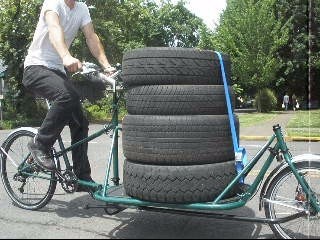
Bakfiets or Box Bikes have built-in cargo cases, usually in the front. (Examples include the Gazelle, Bilenky, Madsen, and two Portland-made bikes: the Metrofiets and the JoeBike pictured below.)
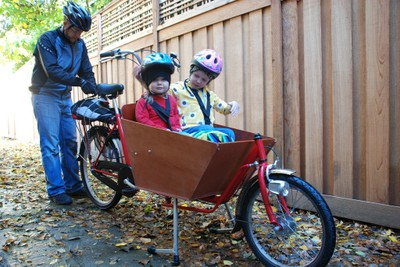
A cargo trike adds not just a crate but also a third wheel. (Examples include Christiania, pictured below, and Velorbis Mobii.)
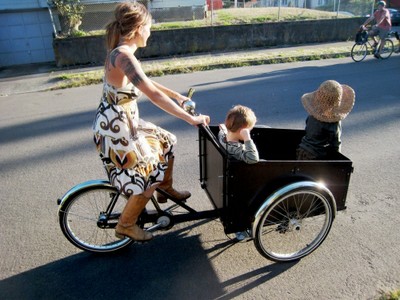
Uses
Cargo bikes of all these types are spreading in the Northwest, and especially in Portland. No one has been counting, so it’s impossible to quantify the trend yet. But my anecdotal observations make me think that cargo bikes are growing at least as fast as electric bikes—a trend I discussed earlier this year.
What interests me most is not the numbers, which remain small enough to be a marginal phenomenon in Northwest transportation. It’s the variety of uses to which people are putting freight-hauling bikes. They’re becoming human-powered pick-ups. Consider:
My friend (and Sightline trustee) Jeff Youngstrom, a gifted photographer, lives car-free in the town of Issaquah, Washington. He uses his longtail for dozens of hauling purposes (many of them documented here). For example, he used it to carry with him all the supplies he needed to set up a photography exhibit at a community art walk.
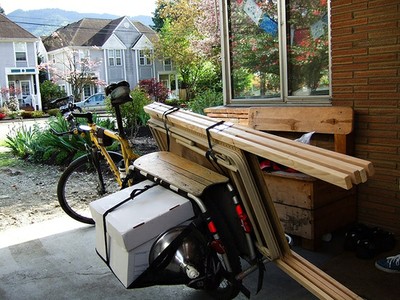
The Portland brewer Hopworks commissioned Portland’s Metrofiets to build it a custom “pub bike” (pictured below). BikePortland.org described it as, “A locally built cargo bike that holds two kegs below an inlaid wood bar. A rear rack is built to hold a stack of pizzas; below that a wood-paneled pannier is in fact a compact sound system.”
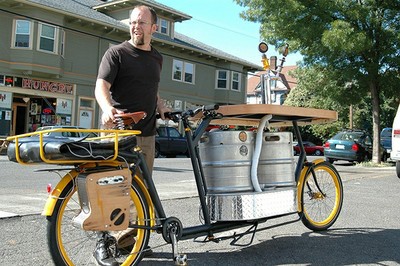
Also in Portland, a small company called B-Line PDX recently started offering delivery services on its cargo bikes (pictured below).
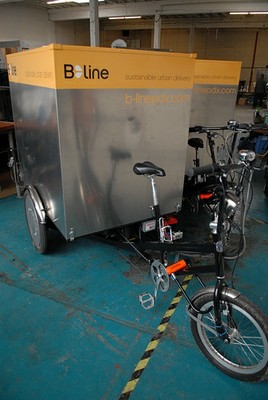
Another Portland-powered cargo bike is the portable library called Street Books that serves people who live outside.
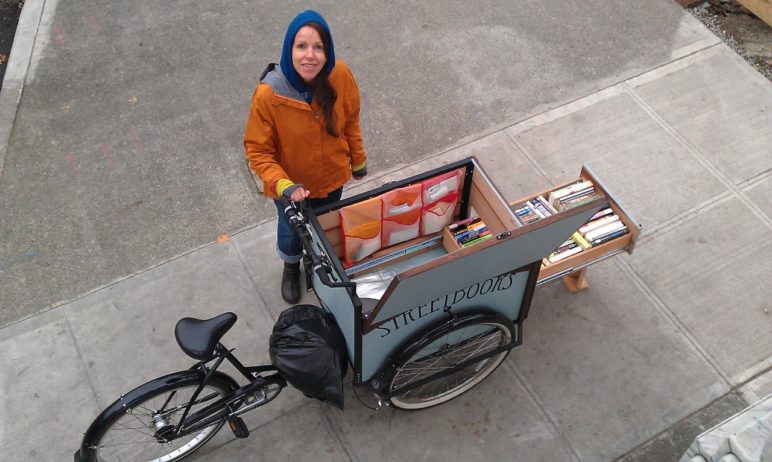
Of course, pedal-powered delivery is nothing new in North America. Bike messengers are a common, if dwindling, breed, but pedal-powered freight delivery is rare. It’s less rare abroad. In Paris, for example, private package carrier DHL delivers by cargo trike, as does a company called TNT elsewhere in Europe. In fact, national postal services in both Denmark and the United Kingdom include bike delivery. Urban planner Alyse Nelson (who helped research this post) photographed this official Danish postal bike (along with an impressive variety of other cargo bikes in Denmark (Flickr set here).
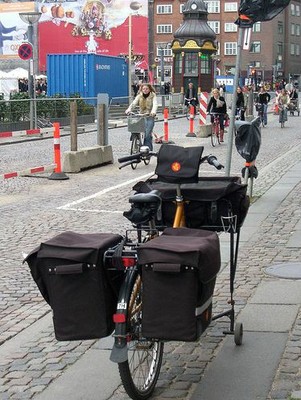
She also shot this picture of a Danish postal cargo trike.
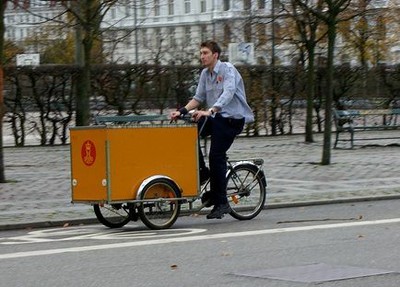
Speaking of delivery, pizzas are starting to travel on bikes. In my neighborhood of Ballard, in Seattle, Snoose Junction sends its pies out on two wheels. Zaw Artisan Pizza does the same from two Seattle locations. In Oregon, so do at least some locations of Old Town Pizza, Hot Lips Pizza, and Pizza Schmizza. I imagine other Portland shops do, too.
(Readers: please fill us in! The time may soon come when it’s impossible to list all the pizza places in the Northwest that deliver by bicycle, but that day has not yet arrived. So help me update this list. Vancouver? Victoria? Eugene? Spokane? Corvallis? Bellingham? Boise? Which pizzerias offer non-petroleum-based pie transport?)
The national submarine sandwich chain Jimmy John’s delivers by bike from at least some of its Northwest stores. (Don’t be surprised that a chain store would do so. In China, even Dominoes Pizza delivers by bike!) And then there’s SoupCycle—a subscription soup, bread, and salad bike delivery company in Portland that supports local farmers. In Port Townsend, Washington, the Recyclery delivers purchased goods from the farmers’ market to people’s homes, and Bob’s Bagels delivers by bike all over town.
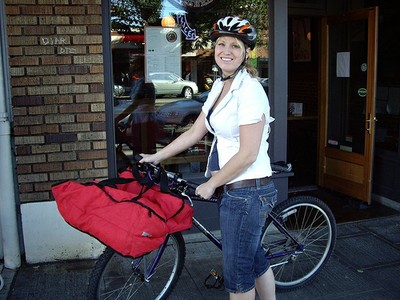
Urban homesteader Patrick Barber of Portland is a pioneer in cargo biking and in-town agriculture. (He’s also a gifted photographer. Check out this set of trike photos. And these.) He and his partner Holly use their cargo trike “like a minivan. We don’t own a car, so we use the trike to carry our daughter, and all her/our associated stuff, to most places that we go in the city. To the farmers market, the grocery store, the park, grandma’s house . . . the library, the garden store, doctors’ appointments.” They even use the trike to pick up and transport out-of-town visitors, such as Patrick’s mom.
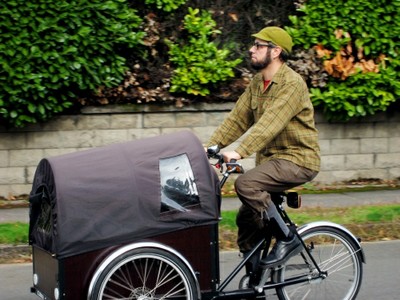
Q19, a home cleaning business in Portland, uses box bikes to haul their cleaning supplies around the city.
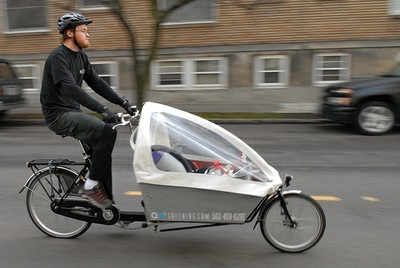
Creative Ferment
Cargo biking seems to bring out the adventuresome side of urban dwellers—a point best made through pictures rather words. For example, some freight bikers like the challenge of carrying challenging and oversized loads, like a gardening enthusiast riding a Portland-made JoeBike long john:
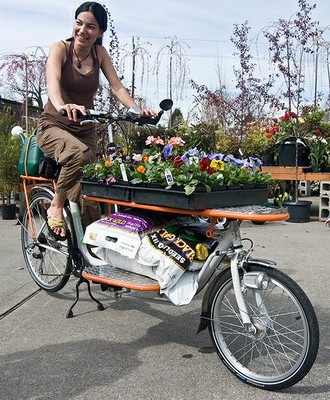
And this door hanger riding a Yuba Mundo:
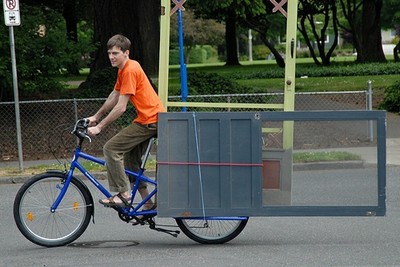
And this teamster on a Bullitt long john:
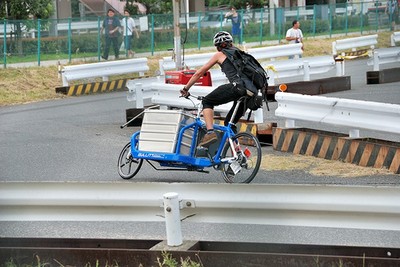
And the person moving this lumber and corrugated cardboard on a Eugene-made CETMA long john:
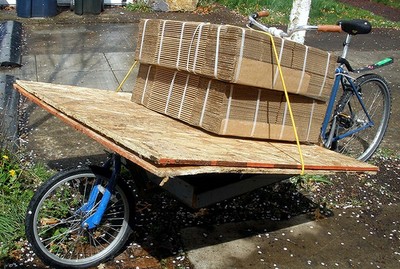
And this apartment mover on a Yuba Mundo long tail:
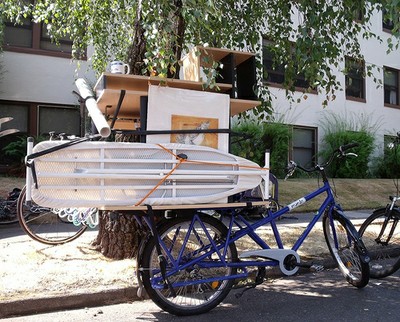
And this man moving boxes on his Truck Trike:
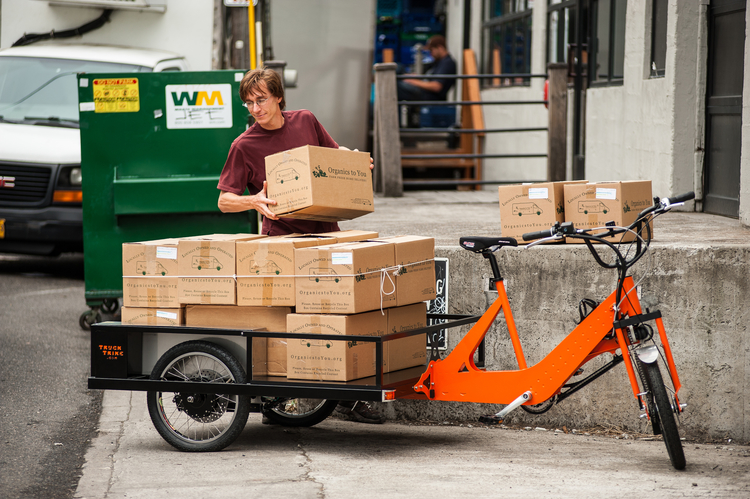
And this mover:
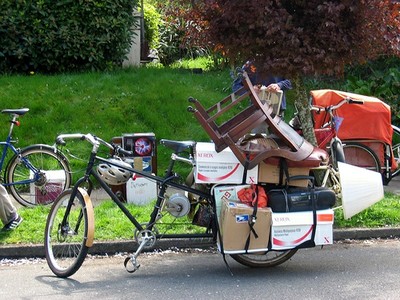
Meanwhile (not pictured), there’s this gentleman who pulls a sailboat on a trailer.
For others, these vehicles are more like passenger trains than freights, whether the passengers are in back . . .
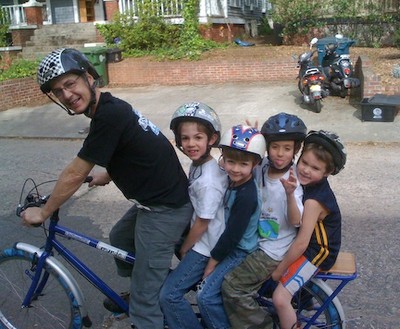
. . . or in front.
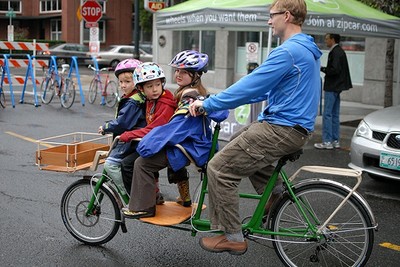
This Fr8 Family model is designed to carry up to three children in their own seats.
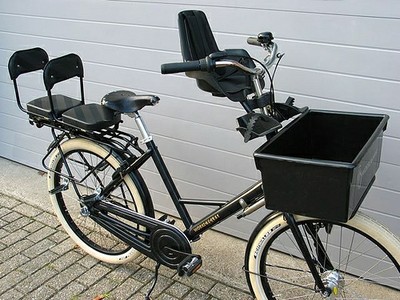
But cargo bikes aren’t just for transporting kids. Here’s an adult musical duo performing while riding in a cargo trike.
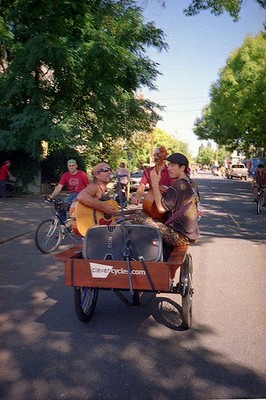
(If you like these photos, many more are here, here, here, and here.)
Whimsy
Cargo bikes can also express an artistic streak which, while it won’t end oil addiction or stop climate change, does add a dash of whimsy to urban life (and some frivolity to this post).
Take, for example, the “cart-bike”—a derelict bike welded to a grocery store shopping cart: “It is quite the head turner,” says its originator, “but not a good corner turner.” (Short video here.)
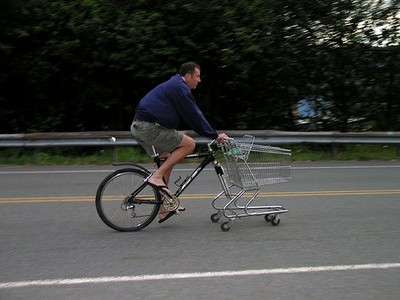
The picnic-table bike is an instant classic, with its built-in grill and sun shade.
A charcoal grill attachment is also possible on a long tail, however, as this Xtracycle video explains.
DIT: EcoDeck – Bar-Be-Que Grill Install from Xtracycle on Vimeo.
Finally, in the absurdist humor category, there is the Waffle Bike, my favorite art bike project. It’s “a fully weaponized waffle making device complete with call to prayer public address system.”
(More novelty cargo bikes, including pedal-powered espresso carts and muscle-driven camper vans, are here. Check them out!)
Picking Up
To pick up my more-serious thread (oops—that reminds me of this fun video of three cargo bikers literally towing a broken pickup), what’s clear from all the inventing and tinkering and experimenting in cargo bikes is that we’ve yet to reach the limits of muscle-powered urban transportation.
I doubt that cargo bikes will ever amount to a substantial share of freight hauling even in cities. The motor is an amazing technology, and hauling large loads is where it makes most sense.
The glimpse beyond carbon addiction is perhaps the greatest public service cargo bikes perform.
Still, cargo bikes seem destined to fill a small but growing niche in our communities. Unlike electric bikes, they fit perfectly into North America’s existing bike culture (macho, anti-auto, lighthearted). They extend options for car-less and car-lite businesses and families. And they make a tremendous amount of sense for certain applications, such as mail and pizza delivery, grocery runs, and in-town service businesses like house cleaners.
As our neighborhoods grow more compact, mixed, and bike-friendly, and when we put a price on carbon, cargo bikes are likely to grow steadily in numbers and uses. They are likely, in fact, to become commonplace—symbols and reminders of how human power and human ingenuity are chipping away at an unreliable, climate-changing, and ocean-endangering petroleum supply.
That glimpse beyond addiction is perhaps the greatest public service they perform.
[button link='{“url”:”http://www.sightline.org/2012/07/12/babes-on-bikes/”,”title”:”Like what you|apos;re reading? Find out how you can tow your tot on a cargo bike here.”}’ color=”orange”]
Huge thanks to volunteer and urban planner Alyse Nelson for doing research that made this post possible.
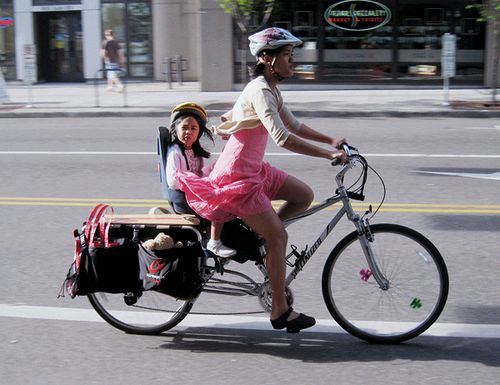

Comments are closed.